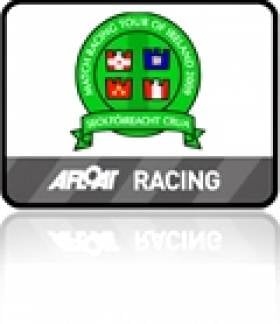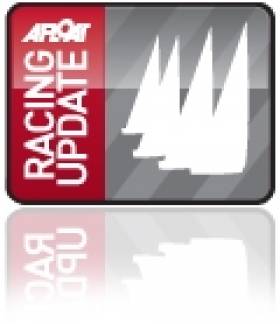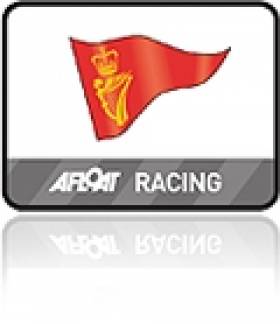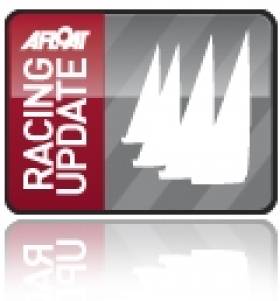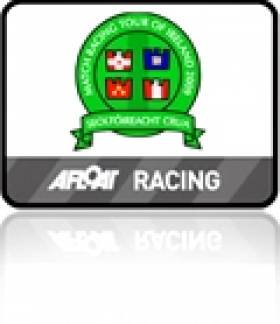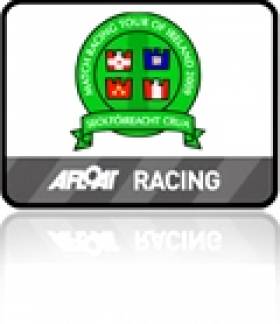Displaying items by tag: Match Racing
Howth Yacht Club's Diana Kissane Match Racing in Busan
Ireland's Diana Kissane is competing at the Busan Cup Women's International Match Race in Southern Korea. It was a tough round robin for the Howth Yacht Club sailor who won two of her 11 races that concluded the series for her today.
The Howth match racer has been on the international circuit racing this season and has already competed at the ISAF Women’s Match Racing Worlds in Middelfart, Denmark in July. Kissane's crew includes Aoife English, Bella Morehead, Jenny Andreasson and Lizzy McDowell.
With three more wins in Friday’s racing in the Busan Cup Women’s International Match Race, Anne-Claire Le Berre of France went to 10 – 1 and winning the round-robin stage. The fight for the 2015 WIM Series title will now heat up, as World #1, but Series’ runner-up, Camilla Ulrikkeholm Klinkby chose American leader Maggie Shea in the quarters:
“We want to be able to do the job ourselves. Beating Maggie is the only way we can take the WIM Series” the Dane states.
“We had a good race against Camilla in the round-robin, and we’re happy to see her again” Shea replies.
Friday morning saw a short postponement at the Busan Cup Women’s International Match Race, the fourth and final event of the 2015 WIM Series, as Regatta Director Alfredo Ricci moved the course from just off of Haeundae Beach to an area closer to the Gwangan Bridge. After just a few minutes with the AP flag flying from the committee boat, the starting sequence commenced in 5 – 7 knots of shifty and puffy breeze, which built to 8 – 12 knots at midday. The shoreline skyscrapers also affected the already unsteady wind:
“It wasn’t that difficult today, as we could clearly see the puffs come rolling down the course, read the wind quite easily and adapt to it” Le Berre comments.
The French World #4 won all three of her Friday matches, finishing the day by defeating compatriot Pauline Courtois, who badly needed a win in that last race to qualify for the quarterfinals:
“We must sail our own race and can’t take into account if the opponent is French or not. We want to win the round-robin, to be able to choose ourselves whom to meet in the quarters” Le Berre explains.
Previously undefeated Katie Spithill saw her first two setbacks today, against Ulrikkeholm Klinkby and Dutch Renée Groeneveld, to finish round-robin runner-up on a 9 – 2 score. But the Aussie wasn’t too upset about her lost matches:
“We made a few mistakes, but it’s better to do them now than later on in the regatta. Pretty much we lost those matches already on the starting line, so we’ll need better prestarts” Spithill analyses.
“It’s a new scorecard now. We’re looking forward to the weekend, and we’re excited to get racing tomorrow” she fills in.
Maggie Shea, substituting for regular Epic Racing skipper, World #2 and WIM Series leader Stephanie Roble, had a tough Friday on the Korean waters, adding two losses to her round-robin score, totalling 7 – 4:
“It wasn’t our best day of racing, but we learned a lot. Actually I’m thankful for the close racing and for the situations that occurred, it’ll help us improve for the weekend” the American skipper says.
Especially grateful for the US mistakes is local hope Sung-Eon Choi, who took her first bullet in her home event by defeating Shea & Co:
“We did a very good start and led all the way around the course, to finish about three boat lengths ahead of the Americans. It was a great feeling!” Choi laughs.
Quarterfinals and semis are planned for Saturday, leaving the final races for Sunday. Three skippers can still win the 2015 WIM Series; Roble/Shea, Ulrikkeholm Klinkby and Swede Anna Östling.
Results in the round-robin of the Busan Cup Women’s International Match Race, the fourth and final event of the 2015 WIM Series (skipper, nationality, wins – losses):
1. Anne-Claire Le Berre, FRA, 10 – 1
2. Katie Spithill, AUS, 9 – 2
3. Camilla Ulrikkeholm Klinkby, DEN, 8 – 3
4. Maggie Shea (substituting for Stephanie Roble), USA, 7 – 4
5. Caroline Sylvan, SWE, 7 – 4
6. Anna Östling, SWE, 6 – 5
7. Renée Groeneveld, NED, 4,5 – 5
8. Denise Lim, SIN, 4 – 7
9. Pauline Courtois, FRA, 4 – 7
10. Milly Bennett, AUS, 3 – 8
11. Diana Kissane, IRL, 2 – 9
12. Sung Eun Choi, KOR, 1 – 10
#matchracing – Howth's Yacht Club's Diana Kissane faces strong opposition in Denmark at the Women's Match Racing World Championship and yesterday strong gusts and a long day conspired to really test the sole Irish entry who sustained six losses, the same as Finnish and Dutch entries
Local hope Lotte Meldgaard and French Anne-Claire Le Berre are the only undefeated skippers after the opening day of the 2015 ISAF Women's Match Racing World Championship, the first event on the 2015 Women's International Match Racing Series (WIM Series), in Middelfart, Denmark. Both scored 8 - 0 on a long and very action-packed Wednesday:
"Even with one reef in the main and a smaller jib replacing the genoa, the Match 28's we're racing here are quite overpowered. We lost control a couple of times, but excellent crew work got us back on track again" Meldgaard comments.
The opening day offered truly challenging conditions for the competitors as well as for the race management. Gusts approaching 30 knots swept down the course, leaving broaching boats, freely flying kites and wet and exhausted sailors behind.
The racing in Middelfart continues with the round-robin Thursday and Friday, while the weekend will see the exciting knock-out rounds to crown the World Champions.
Standings after one day of round-robin in the 2015 ISAF Women's Match Racing World Championship in Middelfart, Denmark, the first event on the 2015 WIM Series (skipper, country, wins - losses):
1. Lotte Meldgaard, DEN, 8 - 0
1. Anne-Claire Le Berre, FRA, 8 - 0
3. Anna Östling, SWE, 7 - 1
4. Camilla Ulrikeholm, DEN, 5 - 1
4. Caroline Sylvan, SWE, 5 - 1
6. Stephanie Roble, USA, 4 - 2
6. Klaartje Zuiderbaan, NED, 4 - 2
8. Pauline Courtois, FRA, 5 - 3
8. Katie Spithill, AUS, 5 - 3
10. Milly Bennett, AUS, 3 - 5
11. Louise Christensen, DEN, 2 - 6
12. Johanna Larsson, SWE, 0 - 6
12. Nina Ramm-Schmidt, FIN, 0 - 6
12. Rikst Dijkstra, NED, 0 - 6
12. Diana Kissane, IRL, 0 - 6
16. Sanna Hager, SWE, 0 - 8
Howth Yacht Club Sailors on World Match Racing Tour
#wmrt – The World Match Racing Tour sees a new expanded schedule for the 2015/16 Season. The tour now consists of two levels of competition. Along with the usual 7 World Championship events the tour now includes a number of smaller competitions which are scored at half points but count towards the overall World Match Racing Tour Standings. Howth sailors Shane Diviney and Scott Flanigan have been competing in the first three regattas of the 2015/16 World Match Racing Tour season. It's another Irish dimension the tour that already sees Cork Match Racer Philip Bendon contest World Match Racing Tour on the Hamble.
Having narrowly missed out on selection for a tour card Diviney and the 36 Below Racing Team, with skipper Chris Steele of New Zealand headed to Long Beach California to compete in the Ficker Cup in early May. The event was a qualifier for the prestigious Congressional Cup to be held the following week. With the top two teams from the Ficker Cup qualifying for the Congressional Cup the objective was clear. The eight teams completed a double round robin in the fleet of evenly matched Catalina 37's. After two days of racing 36 Below Racing came out on top of the qualifying series only losing 2 of their 14 matches. They went on to win their semi-final 2-0. With a berth in the Final awaiting the team were relieved to be assured at least a top two finish and an entry to the Congressional Cup. The final saw the team come up against the local favourite Dustin Durant and his Long Beach Match Racing Team. Their experience in the Catalina 37's was not enough to overcome Steele and his 36 Below Racing team and they went on the win the finals 2-0 and take the Ficker Cup.
The Congressional Cup saw a big step up in the level of competition with most of the World's Top Match racers in attendance, including current World champion Ian Williams and defending Congressional Cup champion, Taylor Canfield. Racing was held just off the end of Long Beach Pier which attracted a big crowd of spectators each day. 36 Below Racing had a strong start to the regatta winning 4 from 5 on the first day of racing. They went on the finish the round robin in 6th position with a record of 6-5 which guaranteed them a spot in the quarter finals. The team came up against fellow Kiwi Phil Robertson in the quarterfinal. Phil sailed three perfect races to take the series 3-0. Although disappointed not to make the semi-finals the team were pleased with their performance in a competitive field. The event was eventually won by Taylor Canfield who beat Robertson 2-1 in a close final.
The World Match Racing Tour then moved to Langenargen, Germany with Scott Flanigan and Shane Diviney joining Mark Lees and his team from the U.K who received a wild card entry to the event. The regatta is known for its light and shifty race course making it extremely challenging to get the heavy Bavaria 40's around the course. The team made an impressive start to their first World Match Racing Tour event with a strong showing in the round robin with a score of 6-5. This left them in 6th place and gave them a spot in the quarter finals. They came up against the very experienced team of Eric Monin and his crew from Switzerland. Monin's experience prevailed as he did a better job of keeping the boat moving around the very light race track to take the series 3-0 in front of a spectator packed lake front. He went on to take second place at the regatta. The team were satisfied with their showing and finished a very credible 6th place.
It is only the beginning of a very busy season for both teams as they prepare to compete in a number of international regattas over the coming months.
#2K – Eight teams from Italy, The Netherlands, Germany, Great Britain and Ireland gathered at the Reale Club Tevere Remo, Rome for the first 2K tour event of 2015. Two days of intense round robin racing saw a three way tie break at the top between Cork, YYCS and Spinnaker.
The final day on Sunday started with rain and no wind but PRO Constanzo Villa managed to get in 4 of the critical race to complete the round robin. The final saw last year's runner up Royal Cork face YCCS. It was the Italians who emerged as winners in a sun drenched final.
Final Results
1st Yacht Club Costa Smeralda
2nd Royal Cork
3rd Spinnaker
4th Dutch Match and Team Racing Association
5th Rome Racing Team
6th Royal Thames
7th Serpentine racing
8th Bavaria Yacht Club
#MatchRacing - Ireland's Diana Kissane will skipper a team in the upcoming Women's International Match Racing Series, how entering its third year of competition.
The Howth Yact Club match racer leads one of the 20 teams already confirmed for the new season, which kicks off 47 days from now at the ISAF Women’s Match Racing Worlds in Middelfart, Denmark from 8-12 July.
That will be followed by the Lysekil Women’s Match in Sweden on 3-8 August, the Buddy Melges Challenge in Sheboygan, Wisconsin on Lake Michigan on 16-20 September, and the Busan Cup in South Korea from 28 October to 1 November.
But first things first, Danish skipper Camilla Ulrikkeholm will be looking to avenge her team's loss to Anna Östling (neé Kjellberg) at the 2014 ISAF Match Racing Worlds in Cork Harbour last June.
“We are never in it not to win it. We will fight for every win this year, as every year,” says Ulrikkeholm, who will have the advantage of home waters for the WIM Series kickoff.
#worldmatchracing – Cork Match Racer Philip Bendon and his team will take on the rising stars of this sailing discipline when the International Sailing Federation's World Match Racing Tour comes to the Hamble in the UK on June 14. Bendon shot to fame when he won the European Match U23 Racing title on Lake Constance in Germany in 2013.
Bendon has since moved up the world rankings substantially from 46 in 2014 to 30 this year but will however meet some red hot talent on the Solent next month.
Just a year ago, GBR's Ian Williams lay second in the ISAF Open rankings. Now he is World Champion both as No.1 in the rankings and the five times winner of the World Match Racing Tour. Ian is top ranked at the Royal Southern Match Cup to be held from 10 to 14 June at Hamble, the first ever World Match Racing Tour event in the UK, and he will be taking on some of the fastest rising stars on the match racing circuit, racing in a fleet of J/80s.
It was also only a year ago that Chris Steele (NZL) was lying 23rd and now he is 11th having already won the Warren Jones Invitational Youth Regatta in Perth and the Oceania final of the ISAF Nations Cup this year.
Matthew Jerwood (AUS) has also shot up the leaderboard going from 150th place to 32nd in the space of 12 months and he is now the reigning Australian champion.
Christian Tang (DEN) has also risen more than 100 places in the last year and comes from the Match Cup Qualifier in Ploen, Germany, with a near perfect score.
Royal Southern Academy Member Annabel Vose (GBR) may be the only girl on the entry list, but she too has risen more than 100 places in the last year and has taken many male scalps to be crowned the RYA Match Racing Youth Champion.
Mark Lees, Connor Miller and Matt Reid, all GBR, and Bendon (IRL) have also all moved substantially up the rankings while Lucasz Wozinski from Poland has climbed nearly 200 places to 86th.
Karen Henderson-Williams, Vice Commodore of the Royal Southern Yacht Club, and former Royal Southern Academy Chairman commented:
"This year's entry list more than fulfils our objective - to bring some of the World's best to Hamble so that our own young sailors can compete against them at home.
"We also have a truly cosmopolitan complement of International Umpires from Croatia, Australia, Italy and UK as we become an official event of the World Match Racing Tour for the first time."
The final line-up of skippers taking part in the 2015 Royal Southern Match Cup are:
Skippers
Ian Williams/GBR
Chris Steele/NZL
Mark Lees/GBR
Philip Bendon/IRL
Matthew Jerwood/AUS
Christian Tang/DEN
Connor Miller/GBR
Annabel Vose/GBR
Lucasz Wozinski/POL
Matthew Reid/GBR
#matchrace – Thirteen teams from eleven nations will compete in the Open series at Howth Yacht Club this week with Ireland represented by experienced match-racer Marty O'Leary and his team - no strangers to Howth waters, having competed here in the Irish Match Racing Championships back in December.
Overseen by the 11 competing European nations, the 2015 ISAF Nation's Cup European Finals in conjunction with McPeake Auctioneers was officially opened by Fingal Mayor Mags Murray in Howth on Wednesday evening. The Mayor wished for fair winds for the sailors and encouraged all involved in this major match-racing championships to enjoy Howth, describing it as 'the jewel of Fingal' with its spectacular coastline and warm and inviting local hospitality.
The Women's championships will be a very competitive event with 5 countries taking part including two Irish teams led by 'youthful veterans' Diana Kissane and Mary O'Loughlin. The Nation's Cup will be a family affair for the Kissanes, as Diana's father Richard (Rear Commodore of HYC) is also chairman of this event.
The umpire and judging team is drawn from five different countries, headed up by French 'Chief Umpire' Thibaut Gridel and also including Kinsale and ISA Sailfleet's own Michael O'Connor. The championships will be sailed in the eight J80s and racing will be managed by Howth Past Commodore, International Race Officer and ISA President David Lovegrove.
Howth Yacht Club's Flanigan Takes Scarlino Match Race Victory With Team GBR
#matchrace – London Olympic sailor Scott Flanigan of Howth Yacht Club was sailing with the Great British Match Racing Team again at the weekend and won the Scarlino Grade 3 match race event, beating world number 17 Tomislav Basic in the final race to take the event.
The win will see the team boosted into the Top 20 in the world rankings for the first time.
Flanigan is sailing with Mark Lees, Matt Haslam and James Hemmingway for the remainder of the season as they target a place on the World Match racing tour for the 2016/17 season.
The event took place in Club Nautico Scarlino, Italy and marked the start of the European match racing circuit. There was 9 teams from 5 nations competing.
A full round robin was completed in extremely wet and variable conditions over two days. Mark Lees' team won 7 of their 8 races, only dropping a race when their spinnaker halyard snapped. The final race against top seed Tomislav Basic from Croatia was the decider, with the GBR match racing team leaving their best sailing till last.
Cork's Philip Bendon was also competing in Antibes, France in another Grade 3 where he finished fourth.
Both teams will be vying for European places at the Nations Cup qualifier in Howth in early May, with the Grand Finals being held in Russia in July.
Team positions:
Mark Lees : Helm
Scott Flanigan: Mainsheet trimmer & tactician
Matt Haslam: Trimmer
James Hemmingway: Bowman
2015 ISAF Youth Match Racing World Championship Notice Of Issued
#matchrace – The Notice of Race for the 2015 ISAF Youth Sailing Match Racing World Championship set to be held in Swinoujscie, Poland from 15 – 19 September 2015 has been released.
Organised by the Polish Match Tour in conjunction with the Polish Yachting Association and the International Sailing Federation (ISAF), this ISAF Grade W event will welcome 12 skippers racing in TOM28 boats.
In its second year following the successful 2014 inaugural edition (won by Joachim Aschenbrenner (DEN) the 2015 ISAF Youth Match Racing World Championship is open to competitors under 23 years old on 31 December 2015.
ISAF Member National Authorities may apply for an invitation for a skipper of their nationality by sending a completed entry form to ISAF no later than 30 April 2015. ISAF will inform MNAs and skippers if they will be issued with an invitation no later than 15 May 2015.
Irish Match Racing Open Curtailed By Strong Winds
#match–race – The much anticipated Irish Match Racing Open has been succesful writes Diana Kissane albeit strong winds on Sunday curtailed the running of a full programme. With 7 domestic teams and 3 UK entries the event attracted some of the top sailors of the British Isles including a host pf sailors competing on the premier mens and womens world tours, former and current national champions. An incredible 36 races were sailed on Saturday between dawn and dusk without a minute being wasted, with the fancied runners establishing a clear lead. With the lead boats all having raced each other, it was possible to obtain a clear result.
Competitors and officials enjoyed a sociable evening at the event dinner in the club last night with the raucous sing song being led by the umpiring team! Those with real stamina ventured onto Findlaters until the small hours. Despite the late night, all crews featured on Sunday morning and given the forecast, it was decided to attempt to run semi finals and finals.
Teams Lees, Vose, Grant and O'Leary went to sea to battle it out but after an hour or so returned with conditions having prevented the run-off.
The final standings were Mark Lees overall winner, Annabel Vose runner-up, third placed Graeme Grant the first Irish boat and Marty O'Leary a close 4th. A fantastic weekend all round!
There are plans in motion for open training sessions and mini reggattas to take place in January.



























